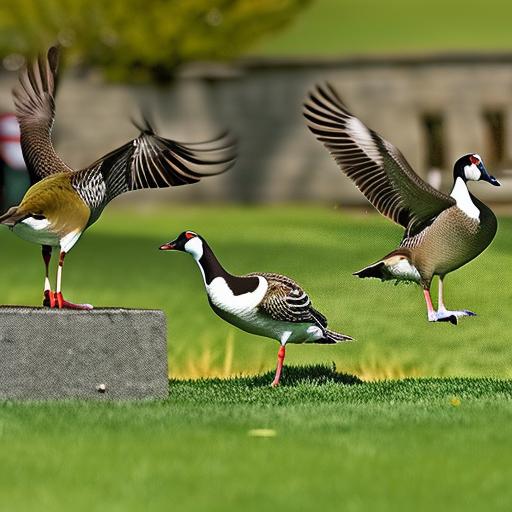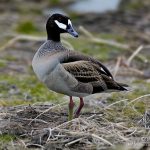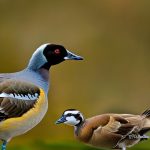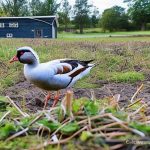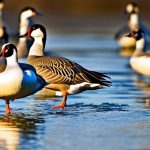Canadian geese invading lawns can be a frustrating problem for many homeowners. These large birds can cause damage to lawns, leave behind droppings that are unsightly and unsanitary, and even become aggressive towards humans or pets. In order to effectively deter Canadian geese from invading your lawn, it is important to understand their behavior and motivations. In this post, we will discuss various methods that can be used to deter geese, including physical barriers, decoys, motion-activated sprinklers, sound deterrents, non-toxic repellents, removing potential food sources, encouraging natural predators, building fences or planting shrubs, and seeking professional help from a wildlife management company.
Key Takeaways
- Canadian geese are attracted to open spaces with easy access to water and food sources.
- Physical barriers, such as fences or shrubs, can prevent geese from accessing your lawn.
- Decoys, such as fake geese or predators, can trick geese into thinking your lawn is already occupied.
- Motion-activated sprinklers can startle geese and deter them from returning to your lawn.
- Sound deterrents, such as noisemakers or predator calls, can also scare geese away.
Understanding the behavior of Canadian geese
Canadian geese are attracted to lawns for several reasons. First, lawns provide a source of food for the geese. They feed on grass and other vegetation found in lawns, as well as any fallen fruit or birdseed that may be present. Second, lawns provide an open space for the geese to rest and relax. They feel safe on lawns because they have a clear view of their surroundings and can easily spot any potential threats. Finally, lawns often have bodies of water nearby, such as ponds or lakes, which provide an additional attraction for the geese.
Understanding the behavior of Canadian geese is crucial in order to choose the most effective deterrents. For example, if you know that geese are attracted to lawns because they provide a source of food, you can focus on methods that remove or discourage food sources. Similarly, if you know that geese feel safe on lawns because they have a clear view of their surroundings, you can focus on methods that create physical barriers or use decoys to make your lawn appear less inviting.
Creating physical barriers to deter geese from entering your lawn
One effective method of deterring geese from entering your lawn is to create physical barriers. There are several types of physical barriers that can be used, including fences and netting. Fences can be made from a variety of materials, such as wood, metal, or plastic, and should be at least three feet high to prevent geese from easily stepping over them. Netting can be used to cover areas where geese are likely to land or feed, such as ponds or gardens.
When installing physical barriers, it is important to make sure they are properly installed and maintained. Fences should be securely anchored into the ground to prevent geese from pushing them over or crawling underneath. Netting should be tightly secured to prevent geese from getting tangled in it or pulling it down. Regular inspections and repairs should be done to ensure that the barriers remain effective.
Using decoys to trick geese into thinking your lawn is already occupied
Another method of deterring geese from invading your lawn is to use decoys. Decoys are objects that resemble geese or predators and are used to trick geese into thinking that your lawn is already occupied. There are several types of decoys that can be used, including fake geese and predator decoys.
Fake geese decoys can be placed on your lawn to make it appear as if there is already a flock of geese present. These decoys should be positioned in a way that mimics the natural behavior of geese, such as grazing or resting. Predator decoys, such as fake owls or coyotes, can also be effective in deterring geese. These decoys should be placed in areas where geese are likely to land or feed.
When using decoys, it is important to properly position and maintain them. Decoys should be moved regularly to prevent geese from becoming accustomed to their presence. They should also be cleaned regularly to prevent the buildup of dirt or debris that could make them less effective.
Installing motion-activated sprinklers to scare geese away
Motion-activated sprinklers can be an effective method of deterring geese from invading your lawn. These sprinklers are equipped with sensors that detect the movement of geese and automatically spray water in their direction. The sudden burst of water startles the geese and encourages them to leave the area.
When installing motion-activated sprinklers, it is important to position them in areas where geese are likely to land or feed. They should be placed at a height that will effectively spray water towards the geese, but not so high that they will be easily triggered by other animals or humans. Regular maintenance should be done to ensure that the sprinklers are functioning properly and that the sensors are not blocked by vegetation or debris.
Using sound deterrents, such as noisemakers or predator calls
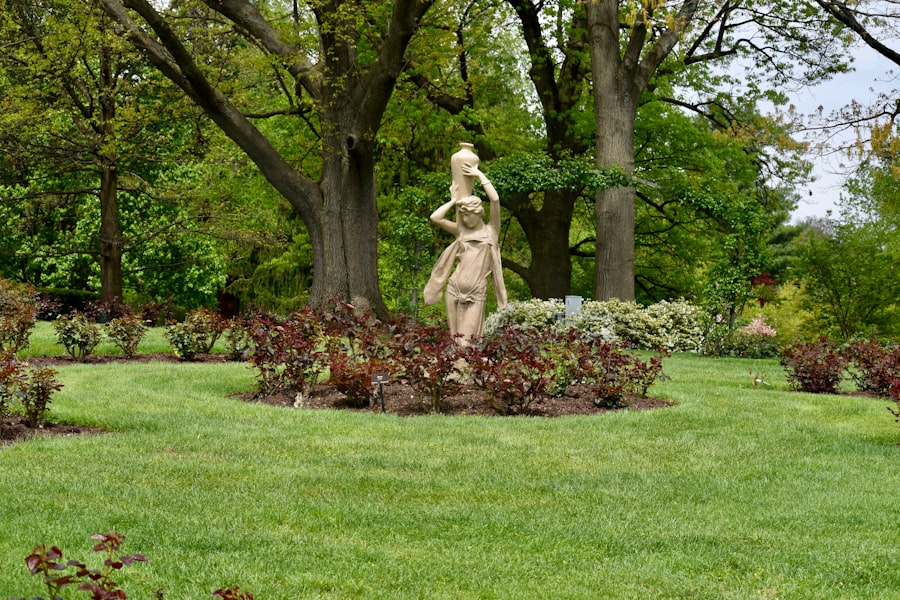
Sound deterrents can also be effective in deterring geese from invading your lawn. These deterrents use loud noises or predator calls to scare geese away. There are several types of sound deterrents that can be used, including noisemakers, such as air horns or whistles, and predator calls, such as recordings of bird distress calls or predator cries.
When using sound deterrents, it is important to properly position and maintain them. Noisemakers should be placed in areas where geese are likely to land or feed, and should be activated when geese are present. Predator calls should be played at regular intervals to create the illusion of a predator presence. Regular inspections and repairs should be done to ensure that the deterrents remain effective.
Applying non-toxic goose repellents to your lawn
Non-toxic goose repellents can be an effective method of deterring geese from invading your lawn. These repellents use natural substances, such as grape extract or garlic spray, to create an unpleasant scent or taste that geese find unappealing. They can be applied directly to your lawn or to areas where geese are likely to land or feed.
When applying non-toxic goose repellents, it is important to follow the instructions provided by the manufacturer. Repellents should be applied at regular intervals to maintain their effectiveness. It is also important to regularly inspect your lawn for any signs of damage or wear that may require reapplication.
Removing potential food sources, such as fallen fruit or birdseed, from your lawn
One of the most effective methods of deterring geese from invading your lawn is to remove potential food sources. Geese are attracted to lawns that provide a source of food, such as grass, fallen fruit, or birdseed. By removing these food sources, you can make your lawn less appealing to geese.
To remove potential food sources, it is important to regularly clean up your lawn. This includes raking up fallen leaves or fruit, removing any spilled birdseed, and regularly mowing your grass to prevent it from becoming overgrown. Regular inspections should be done to ensure that no new food sources have appeared.
Encouraging natural predators, such as hawks or foxes, to frequent your area
Another method of deterring geese from invading your lawn is to encourage natural predators to frequent your area. Geese are wary of predators and will avoid areas where they feel threatened. By attracting natural predators, such as hawks or foxes, you can create a natural deterrent for geese.
To attract natural predators, it is important to create a habitat that is suitable for them. This can include providing nesting sites or perches for birds of prey, planting shrubs or trees that provide cover for predators, and creating a diverse ecosystem that supports a variety of wildlife. Regular maintenance should be done to ensure that the habitat remains suitable for predators.
Building a fence or planting shrubs to block geese from accessing your lawn
Building a fence or planting shrubs can be an effective method of deterring geese from accessing your lawn. These physical barriers create a barrier that geese are unable to cross, preventing them from entering your lawn.
When building a fence, it is important to choose a material that is sturdy and durable. The fence should be at least three feet high to prevent geese from easily stepping over it. It should also be securely anchored into the ground to prevent geese from pushing it over or crawling underneath. Regular inspections and repairs should be done to ensure that the fence remains effective.
When planting shrubs, it is important to choose species that are dense and provide good coverage. The shrubs should be planted close together to create a barrier that geese are unable to pass through. Regular pruning and maintenance should be done to ensure that the shrubs remain effective.
Seeking professional help from a wildlife management company if geese become a persistent problem
If geese become a persistent problem and none of the methods discussed in this post are effective, it may be necessary to seek professional help from a wildlife management company. These companies specialize in dealing with wildlife-related issues and can provide expert advice and assistance in deterring geese.
When seeking professional help, it is important to find and choose a reputable wildlife management company. This can be done by asking for recommendations from friends or neighbors, conducting online research, or contacting local government agencies or organizations that deal with wildlife issues. It is also important to ask for references and check the company’s credentials and certifications.
In conclusion, there are several methods that can be used to effectively deter Canadian geese from invading lawns. These methods include creating physical barriers, using decoys, installing motion-activated sprinklers, using sound deterrents, applying non-toxic repellents, removing potential food sources, encouraging natural predators, building fences or planting shrubs, and seeking professional help from a wildlife management company. It is important to try different methods and find what works best for your situation. By understanding the behavior of Canadian geese and using the appropriate deterrents, you can successfully protect your lawn from these invasive birds.
If you’re looking for ways to keep Canadian geese off your lawn, you might also be interested in learning about how many eggs geese lay. Understanding their breeding habits can provide valuable insights into their behavior and help you develop effective strategies for deterring them. Check out this informative article on poultrywizard.com to discover fascinating facts about geese reproduction and gain a deeper understanding of these majestic birds.
FAQs
What are Canadian geese?
Canadian geese are a species of waterfowl that are native to North America. They are known for their distinctive black heads and necks, white cheeks, and brown bodies.
Why do Canadian geese come onto lawns?
Canadian geese are attracted to lawns because they provide a source of food and water. They also offer a safe place for geese to rest and raise their young.
What problems can Canadian geese cause on lawns?
Canadian geese can cause a number of problems on lawns, including damaging grass and landscaping, leaving droppings that can be unsightly and unsanitary, and creating noise and disturbance.
What are some methods for keeping Canadian geese off lawns?
Some methods for keeping Canadian geese off lawns include using decoys, installing fencing or netting, using repellents, and modifying the landscape to make it less attractive to geese.
Are there any legal restrictions on how to keep Canadian geese off lawns?
Yes, there are legal restrictions on how to keep Canadian geese off lawns. Canadian geese are protected under the Migratory Bird Treaty Act, which means that it is illegal to harm or kill them without a permit. It is important to use humane and non-lethal methods for keeping geese off lawns.
Meet Walter, the feathered-friend fanatic of Florida! Nestled in the sunshine state, Walter struts through life with his feathered companions, clucking his way to happiness. With a coop that’s fancier than a five-star hotel, he’s the Don Juan of the chicken world. When he’s not teaching his hens to do the cha-cha, you’ll find him in a heated debate with his prized rooster, Sir Clucks-a-Lot. Walter’s poultry passion is no yolk; he’s the sunny-side-up guy you never knew you needed in your flock of friends!

